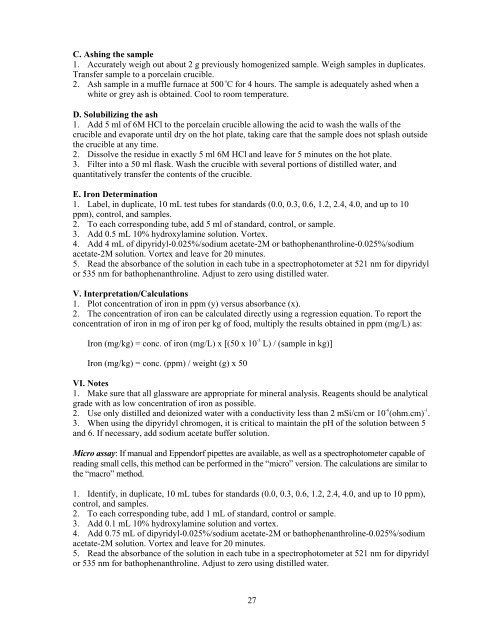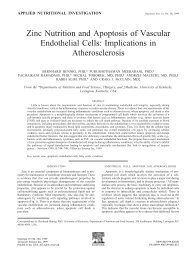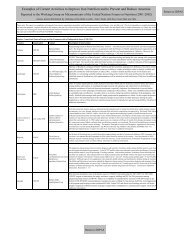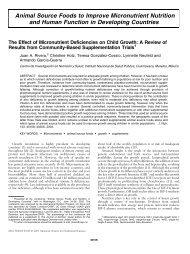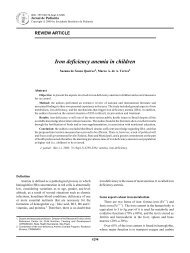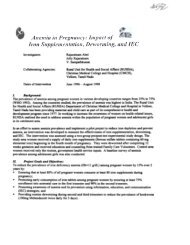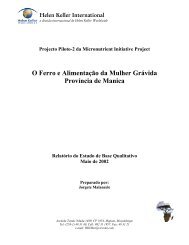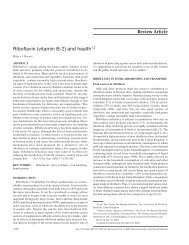WHEAT FLOUR FORTIFICATION WITH IRON - Idpas.org
WHEAT FLOUR FORTIFICATION WITH IRON - Idpas.org
WHEAT FLOUR FORTIFICATION WITH IRON - Idpas.org
Create successful ePaper yourself
Turn your PDF publications into a flip-book with our unique Google optimized e-Paper software.
C. Ashing the sample<br />
1. Accurately weigh out about 2 g previously homogenized sample. Weigh samples in duplicates.<br />
Transfer sample to a porcelain crucible.<br />
2. Ash sample in a muffle furnace at 500 o C for 4 hours. The sample is adequately ashed when a<br />
white or grey ash is obtained. Cool to room temperature.<br />
D. Solubilizing the ash<br />
1. Add 5 ml of 6M HCl to the porcelain crucible allowing the acid to wash the walls of the<br />
crucible and evaporate until dry on the hot plate, taking care that the sample does not splash outside<br />
the crucible at any time.<br />
2. Dissolve the residue in exactly 5 ml 6M HCl and leave for 5 minutes on the hot plate.<br />
3. Filter into a 50 ml flask. Wash the crucible with several portions of distilled water, and<br />
quantitatively transfer the contents of the crucible.<br />
E. Iron Determination<br />
1. Label, in duplicate, 10 mL test tubes for standards (0.0, 0.3, 0.6, 1.2, 2.4, 4.0, and up to 10<br />
ppm), control, and samples.<br />
2. To each corresponding tube, add 5 ml of standard, control, or sample.<br />
3. Add 0.5 mL 10% hydroxylamine solution. Vortex.<br />
4. Add 4 mL of dipyridyl-0.025%/sodium acetate-2M or bathophenanthroline-0.025%/sodium<br />
acetate-2M solution. Vortex and leave for 20 minutes.<br />
5. Read the absorbance of the solution in each tube in a spectrophotometer at 521 nm for dipyridyl<br />
or 535 nm for bathophenanthroline. Adjust to zero using distilled water.<br />
V. Interpretation/Calculations<br />
1. Plot concentration of iron in ppm (y) versus absorbance (x).<br />
2. The concentration of iron can be calculated directly using a regression equation. To report the<br />
concentration of iron in mg of iron per kg of food, multiply the results obtained in ppm (mg/L) as:<br />
Iron (mg/kg) = conc. of iron (mg/L) x [(50 x 10 -3 L) / (sample in kg)]<br />
Iron (mg/kg) = conc. (ppm) / weight (g) x 50<br />
VI. Notes<br />
1. Make sure that all glassware are appropriate for mineral analysis. Reagents should be analytical<br />
grade with as low concentration of iron as possible.<br />
2. Use only distilled and deionized water with a conductivity less than 2 mSi/cm or 10 -6 (ohm.cm) -1 .<br />
3. When using the dipyridyl chromogen, it is critical to maintain the pH of the solution between 5<br />
and 6. If necessary, add sodium acetate buffer solution.<br />
Micro assay: If manual and Eppendorf pipettes are available, as well as a spectrophotometer capable of<br />
reading small cells, this method can be performed in the “micro” version. The calculations are similar to<br />
the “macro” method.<br />
1. Identify, in duplicate, 10 mL tubes for standards (0.0, 0.3, 0.6, 1.2, 2.4, 4.0, and up to 10 ppm),<br />
control, and samples.<br />
2. To each corresponding tube, add 1 mL of standard, control or sample.<br />
3. Add 0.1 mL 10% hydroxylamine solution and vortex.<br />
4. Add 0.75 mL of dipyridyl-0.025%/sodium acetate-2M or bathophenanthroline-0.025%/sodium<br />
acetate-2M solution. Vortex and leave for 20 minutes.<br />
5. Read the absorbance of the solution in each tube in a spectrophotometer at 521 nm for dipyridyl<br />
or 535 nm for bathophenanthroline. Adjust to zero using distilled water.<br />
27


